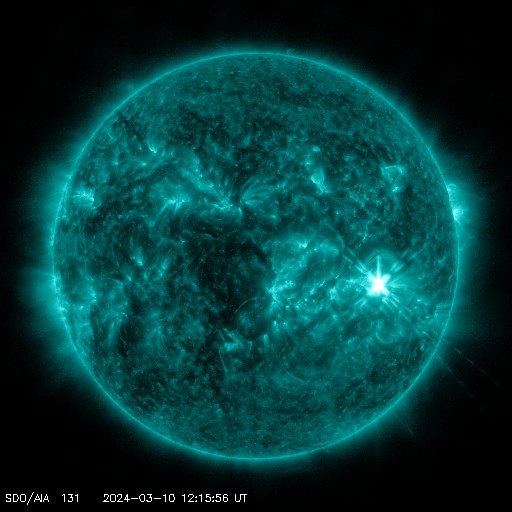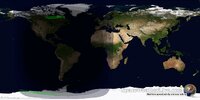SOLAR CYCLE 25 ACTIVITY REPORT MARCH 04_2024
On March 03 Active geomagnetic conditions (kp4) were reached at 13:30 UTC. Minor G1 geomagnetic storm (Kp5) threshold reached at 14:24 UTC Moderate G2 geomagnetic storm (Kp6) threshold reached at 20:59 UTC SpaceWeather.com
Aurora Oval Bz: 0.16 nT North

Solar activity has been at low levels for the past 24 hours. The largest solar event of the period was a C3 event observed at 1729 UTC
The total number of sunspots has decreased to 90 of which 21 of them are grouped into 8 active regions as follows: AR3591, AR3592,
AR3595, AR3596, AR3598, AR3599, AR3600 & new region AR3601

NOAA's solar flare forecast was updated for the next 24 hours: 85% chance of C flares, 25% chance of M flares and 1% chance of X flares. AR3595 has a beta-gamma magnetic field that harbors energy for M-class flares. All other regions have a stable magnetic field.
● Auroral Activity
The geomagnetic field has been at quiet to minor storm levels for the past 24 hours. Solar wind speed reached a peak of 481 km/s (Elevated speed) at 0528 UTC Total IMF reached 19 nT at 11: 08 UTC (strong impact to the Earth's magnetic field)
The total number of sunspots has decreased to 90 of which 21 of them are grouped into 8 active regions as follows: AR3591, AR3592,
AR3595, AR3596, AR3598, AR3599, AR3600 & new region AR3601
NOAA's solar flare forecast was updated for the next 24 hours: 85% chance of C flares, 25% chance of M flares and 1% chance of X flares. AR3595 has a beta-gamma magnetic field that harbors energy for M-class flares. All other regions have a stable magnetic field.
● Auroral Activity
The geomagnetic field has been at quiet to minor storm levels for the past 24 hours. Solar wind speed reached a peak of 481 km/s (Elevated speed) at 0528 UTC Total IMF reached 19 nT at 11: 08 UTC (strong impact to the Earth's magnetic field)
A shock in the solar wind was observed around 08:47 UTC this morning. The shock is possibly related to partial halo coronal mass ejection launched February 28. Taking into account the current solar wind and IMF conditions, geomagnetic conditions are expected to rise to storm levels within the next couple of hours. SpaceWeatherlive on X
THE CME HAS ARRIVED: An overdue CME struck Earth's magnetic field on March 3rd (0930 UT). The impact sparked a G2-class geomagnetic storm with bright auroras around the Arctic Circle. SpaceWeather.com
On March 03 Active geomagnetic conditions (kp4) were reached at 13:30 UTC. Minor G1 geomagnetic storm (Kp5) threshold reached at 14:24 UTC Moderate G2 geomagnetic storm (Kp6) threshold reached at 20:59 UTC SpaceWeather.com
SUBSIDING STORM: A geomagnetic storm triggered by today's stronger-than-expected CME impact is subsiding now. Although storm levels are trending below G1 (Minor), high-latitude sky watchers should remain alert for auroras. The storm could re-energize itself as Earth passes through the CME's turbulent wake. SpaceWeather.com
Aurora Oval Bz: 0.16 nT North
● Current Conditions at 04:42 UTC on March 04
Geomagnetic activity is at index Kp4 (active) after a brief period of a G2 geomagnetic storm. The CME mass hit the magnetic field harder than expected. The solar wind reached elevated velocities, however, at the time of this report the velocity remains at normal levels above 350 km/s. Although conditions for auroral observations at high latitudes are moderate, there were reports of auroras during the geomagnetic storm. The interplanetary magnetic field (IMF) has a strong impact on the Earth's magnetic field, reaching 13 nT. The last recorded solar flare was a C2 at 03:16 UTC.
▪︎ Geospace active (Kp 4)
▪Solar wind speed record: 371 km/sec (Normal speed)
▪︎ density: 2.53 p/cm³ (low density)
▪︎ Interplanetary Magnetic Field (IMF)
Bt: 13 nT
▪︎ X-ray Solar Flare: C2 0316 UT Mar04
▪︎ Thermosphere Climate Index
today: Warm
▪︎ Neutron Counts today: -3.8% (Low)
▪︎ Sunspot number: 90 (SN 92 Mar 03)
▪︎ Spotless Days 2023 total: 0 days (0%)
.......
SpaceWeatherlive.com
SpaceWeather.com
Geomagnetic activity is at index Kp4 (active) after a brief period of a G2 geomagnetic storm. The CME mass hit the magnetic field harder than expected. The solar wind reached elevated velocities, however, at the time of this report the velocity remains at normal levels above 350 km/s. Although conditions for auroral observations at high latitudes are moderate, there were reports of auroras during the geomagnetic storm. The interplanetary magnetic field (IMF) has a strong impact on the Earth's magnetic field, reaching 13 nT. The last recorded solar flare was a C2 at 03:16 UTC.
▪︎ Geospace active (Kp 4)
▪Solar wind speed record: 371 km/sec (Normal speed)
▪︎ density: 2.53 p/cm³ (low density)
▪︎ Interplanetary Magnetic Field (IMF)
Bt: 13 nT
▪︎ X-ray Solar Flare: C2 0316 UT Mar04
▪︎ Thermosphere Climate Index
today: Warm
▪︎ Neutron Counts today: -3.8% (Low)
▪︎ Sunspot number: 90 (SN 92 Mar 03)
▪︎ Spotless Days 2023 total: 0 days (0%)
.......
SpaceWeatherlive.com
SpaceWeather.com




